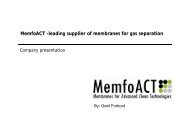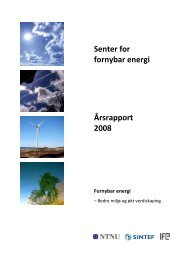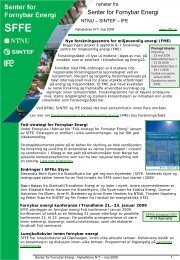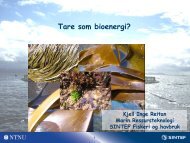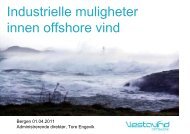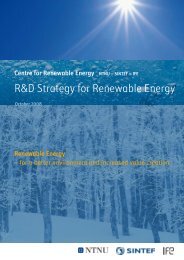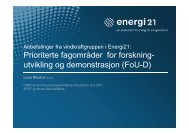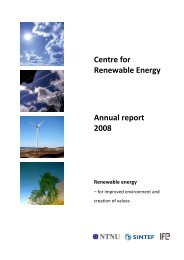Heat Pumps - SFFE
Heat Pumps - SFFE
Heat Pumps - SFFE
You also want an ePaper? Increase the reach of your titles
YUMPU automatically turns print PDFs into web optimized ePapers that Google loves.
<strong>Heat</strong> Pump Systems in Norway<br />
Technology and Market Potential<br />
Jørn Stene<br />
SINTEF Energy Research – Dept. of Energy Processes<br />
NTNU, Dept. of Energy and Process Technology<br />
Centre for Renewable Energy (<strong>SFFE</strong>) – SINTEF-NTNU-IFE<br />
1
The <strong>Heat</strong> Pump<br />
An Energy Efficient Technology that Moves Thermal Energy<br />
HEATING<br />
(30 to 90°C)<br />
• Space heating<br />
• Hot water<br />
• Ventilation air<br />
Q=100%<br />
⎛ Q<br />
COP = ⎜<br />
⎝ P<br />
P=20-50%<br />
⎞<br />
⎟<br />
⎠<br />
50-80%<br />
SOURCE<br />
(-20 to 20°C)<br />
• Sea water<br />
• Ground water<br />
• Rock<br />
• Soil (ground)<br />
• Ambient air<br />
• Waste heat<br />
COOLING<br />
• Space cooling<br />
• Computer cooling<br />
SUPPLIED<br />
ELECTRICITY<br />
Centre for Renewable Energy (<strong>SFFE</strong>) – SINTEF-NTNU-IFE<br />
2
Example – Groundwater as <strong>Heat</strong> Source<br />
Principle Design – System for Combined <strong>Heat</strong>ing and Cooling<br />
River<br />
Basin<br />
<strong>Heat</strong> pump<br />
Groundwater table<br />
Infiltration<br />
well<br />
Well<br />
Centre for Renewable Energy (<strong>SFFE</strong>) – SINTEF-NTNU-IFE<br />
3
Example – Hard Rock as <strong>Heat</strong> Source<br />
Principle Design – System for Combined <strong>Heat</strong>ing and Cooling<br />
<strong>Heat</strong> Pump<br />
5°C<br />
OD 40 mm<br />
plastic tubes<br />
with circulating<br />
anti-freeze fluid<br />
5°C<br />
<strong>Heat</strong>ing mode – heat source<br />
Cooling mode – heat sink<br />
Centre for Renewable Energy (<strong>SFFE</strong>) – SINTEF-NTNU-IFE<br />
4
<strong>Heat</strong> <strong>Pumps</strong> and Renewable Energy<br />
COP vs. Energy Saving and Renewable <strong>Heat</strong>ing and Cooling<br />
• 50 – 80% of the supplied heat is renewable energy<br />
• The energy saving equals the heat from the renewable heat source<br />
• 0 – 100% of the supplied cooling is renewable energy<br />
• The energy saving equals the cooling energy from the renewable heat source<br />
50%<br />
33%<br />
25%<br />
20%<br />
50%<br />
67%<br />
75%<br />
80%<br />
COP=2<br />
COP=3<br />
COP=4<br />
COP=5<br />
Centre for Renewable Energy (<strong>SFFE</strong>) – SINTEF-NTNU-IFE<br />
5
<strong>Heat</strong> <strong>Pumps</strong> – Energy Saving<br />
Systems for <strong>Heat</strong>ing and Cooling of All Kinds of Buildings<br />
Renewable heating/cooling<br />
80%<br />
100%<br />
Primary energy demand<br />
20%<br />
• <strong>Heat</strong>ing – electricity or gas<br />
• Cooling – separate air-cond. system<br />
• <strong>Heat</strong>ing – heat pump system<br />
• Cooling – free cooling + heat pump<br />
Centre for Renewable Energy (<strong>SFFE</strong>) – SINTEF-NTNU-IFE<br />
6
<strong>Heat</strong> Pump Systems for <strong>Heat</strong>ing<br />
and Cooling of Different Buildings<br />
• Space heating<br />
• <strong>Heat</strong>ing of ventilation air<br />
• Hot water heating<br />
• Space cooling, computer cooling<br />
Air-to-air heat pump<br />
5 kW<br />
Seawater heat pump<br />
900 kW<br />
Compact unit<br />
2 kW<br />
Ground-source heat pump<br />
8 kW<br />
Sewage heat pump<br />
28,000 kW<br />
Centre for Renewable Energy (<strong>SFFE</strong>) – SINTEF-NTNU-IFE<br />
7
Ambient Air-to-Air <strong>Heat</strong> <strong>Pumps</strong><br />
Residential Installations<br />
• <strong>Heat</strong> source – ambient air<br />
• <strong>Heat</strong>ing and cooling<br />
• <strong>Heat</strong>s/recirculates the indoor air by means<br />
of one/several indoor units/condensers<br />
• No domestic hot water (DHW) heating<br />
• Provides space cooling in reversed mode<br />
(4-way valve)<br />
• Performance and COP<br />
• <strong>Heat</strong>ing capacity and COP drops with<br />
decreasing ambient air temperature<br />
• Peak load heating system required<br />
• Technology and market in Norway<br />
• Large differences in quality for the units<br />
• Excellent sales figures the last 4 years<br />
Centre for Renewable Energy (<strong>SFFE</strong>) – SINTEF-NTNU-IFE<br />
8
Ambient Air-to-Water <strong>Heat</strong> <strong>Pumps</strong><br />
Residential Installations<br />
• <strong>Heat</strong> source – ambient air<br />
• Technology and operating characteristics<br />
related to air-to-air heat pumps<br />
• <strong>Heat</strong>ing and cooling<br />
• Hot water heating – many different<br />
designs, some with low COP<br />
• Space heating supplied by means of a<br />
hydronic heat distribution system<br />
• Some system provide space cooling<br />
• Increasing sales figures in Norway<br />
• R&D activities at NTNU-SINTEF<br />
• CO 2<br />
heat pump technology licensed to<br />
Japanese companies – more that 1 million<br />
HPWH units sold between 2002-2007<br />
CO 2<br />
heat pump (Japan)<br />
Centre for Renewable Energy (<strong>SFFE</strong>) – SINTEF-NTNU-IFE<br />
9
Exhaust Air <strong>Heat</strong> <strong>Pumps</strong><br />
Low-Energy and Passive Buildings<br />
• <strong>Heat</strong> sources<br />
• Exhaust or discharge air from the house<br />
• Extra heat source – (preheated) ambient air<br />
• <strong>Heat</strong>ing and cooling<br />
• Domestic hot water (DHW) heating<br />
• Reheating of ventilation air<br />
• Space heating – hydronic or air-based<br />
• Possibly cooling of the inlet air<br />
• COP – heat sources – Norwegian market<br />
• System with only exhaust air as heat source<br />
have limited heating capacity (1.5-2.5 kW)<br />
• Systems with two heat sources have higher<br />
heating capacity and achieves higher COP<br />
• Recently introduced in Norway<br />
Compact unit, 2 kW (CHVD)<br />
Centre for Renewable Energy (<strong>SFFE</strong>) – SINTEF-NTNU-IFE<br />
10
Seawater <strong>Heat</strong> <strong>Pumps</strong><br />
Non Res. Bldgs and District <strong>Heat</strong>ing/Cooling Systems<br />
• <strong>Heat</strong> source<br />
• Seawater (the Gulf Stream, 4-8°C) – direct or<br />
indirect system design<br />
• <strong>Heat</strong>ing and cooling<br />
• Space heating<br />
• Hot water heating<br />
• <strong>Heat</strong>ing of ventilation air<br />
• Cooling – free cooling or chiller operation<br />
• COP – heat source – Norwegian market<br />
• Suitable temperature level – excellent as heat<br />
source and heat sink (free cooling)<br />
• Requires adequate heat source system in<br />
order to avoid fouling, freezing and corrosion<br />
• Several hundred large installations in Norway<br />
Royal Garden Hotel, Tr.heim – 700 kW<br />
Fornebu – 12 (25) MW<br />
Centre for Renewable Energy (<strong>SFFE</strong>) – SINTEF-NTNU-IFE<br />
11
Groundwater <strong>Heat</strong> <strong>Pumps</strong><br />
Non Res. Bldgs. and District <strong>Heat</strong>ing/Cooling Systems<br />
• <strong>Heat</strong> source<br />
• Groundwater from 15-300 meter deep wells<br />
in sand/gravel or hard rock<br />
• <strong>Heat</strong>ing and cooling<br />
• Space heating<br />
• Hot water heating<br />
• <strong>Heat</strong>ing of ventilation air<br />
• Cooling – free cooling or chiller operation<br />
• COP – heat source – Norwegian market<br />
• Suitable temperature level – excellent as<br />
heat source and heat sink (free cooling)<br />
• Requires clean groundwater in order to<br />
prevent fouling in heat exchangers/pumps<br />
• Relatively few large installations in Norway<br />
Lena Terrasse, Melhus – 260 kW<br />
Oslo Airport, Gardermoen – 8 MW<br />
Centre for Renewable Energy (<strong>SFFE</strong>) – SINTEF-NTNU-IFE<br />
12
Ground-Source (Rock) <strong>Heat</strong> <strong>Pumps</strong><br />
Non Res. Bldgs and District <strong>Heat</strong>ing/Cooling Systems<br />
• <strong>Heat</strong> source<br />
• 150-200 metres vertical boreholes in hard rock<br />
– indirect systems with PE borehole HX<br />
• <strong>Heat</strong>ing and cooling<br />
• Space heating<br />
• Hot water heating<br />
• <strong>Heat</strong>ing of ventilation air<br />
• Cooling – free cooling or chiller operation<br />
• COP – heat source – Norwegian market<br />
• Suitable temperature level – excellent as heat<br />
source and heat sink (free cooling)<br />
• Indirect system design leads to high reliability<br />
and minimum maintenance<br />
• 250 medium- and large-capacity systems and<br />
15.000 resi-dential installations in Norway<br />
Alnafossen kontorpark – 1200 kW<br />
54 boreholes, each 200 metres deep<br />
Nydalen Næringspark – 6 MW<br />
160 boreholes, each 200 metres deep<br />
Centre for Renewable Energy (<strong>SFFE</strong>) – SINTEF-NTNU-IFE<br />
13
Sewage <strong>Heat</strong> <strong>Pumps</strong><br />
District <strong>Heat</strong>ing and Cooling Systems<br />
• <strong>Heat</strong> source<br />
• Untreated or treated sewage<br />
• <strong>Heat</strong>ing and cooling<br />
• Space heating<br />
• Hot water heating<br />
• <strong>Heat</strong>ing of ventilation air<br />
• Cooling – separate district cooling grid<br />
• COP – heat source – Norwegian market<br />
• Relatively high and constant temperature<br />
level leads to high seasonal COP<br />
• Sewage is a very demanding heat source<br />
with regard to handling, cleaning etc.<br />
• 5 large-capacity installations in Norway<br />
Skøyen Vest, Oslo – 28 MW<br />
The largest heat pump in Norway!<br />
Centre for Renewable Energy (<strong>SFFE</strong>) – SINTEF-NTNU-IFE<br />
14
Large specific energy<br />
demands in office buildings<br />
250-350 kWh/(m 2 y)<br />
Source – Enova SF<br />
Centre for Renewable Energy (<strong>SFFE</strong>) – SINTEF-NTNU-IFE<br />
15
Low-Energy Building – Case 1<br />
Telenor’s Office Building – Kokstad (Bergen)<br />
Smart<br />
building!<br />
Photo – Telenor Eiendom<br />
• Excellent building envelope<br />
– adequate solar shading<br />
• Efficient ventilation system<br />
• Efficient distribution systems<br />
for heating and cooling<br />
• Advanced control system<br />
• <strong>Heat</strong> pump systems for<br />
heating and cooling<br />
• Exhaust air heat pump in the<br />
ventilation system<br />
• Ambient air heat pump in<br />
comb. with district heating<br />
• Completed 2001 – measured specific energy demand – 110 kWh/(m 2 år)<br />
Centre for Renewable Energy (<strong>SFFE</strong>) – SINTEF-NTNU-IFE<br />
16
Low-Energy Building – Case 2<br />
Bravida’s Office Building – Fredrikstad<br />
Smart<br />
building!<br />
Drawing from Heidi Mauritzen, Bravida<br />
• Excellent building envelope<br />
– adequate solar shading<br />
• Efficient ventilation system<br />
• Efficient distribution systems<br />
for heating cooling<br />
• Advanced control system<br />
• <strong>Heat</strong> pump system for<br />
heating and cooling<br />
• <strong>Heat</strong> pump connected to 20<br />
energy wells in hard rock –<br />
free cooling<br />
• Pellet boiler + solar heaters<br />
• Completed 2003 – measured specific energy demand – 100 kWh/(m 2 år)<br />
Centre for Renewable Energy (<strong>SFFE</strong>) – SINTEF-NTNU-IFE<br />
17
Low-Energy Building – Case 3<br />
Sig. Halvorsen’s Office Building – Sandnes<br />
Smart<br />
building!<br />
Photo – Sig. Halvorsen<br />
• Excellent building envelope<br />
– adequate solar shading<br />
• Efficient ventilation system<br />
• Efficient distribution systems<br />
for heating cooling<br />
• Advanced control system<br />
• <strong>Heat</strong> pump system for<br />
heating and cooling<br />
• Exhaust air heat pump in the<br />
ventilation system<br />
• <strong>Heat</strong> pump connected to 4<br />
energy wells in hard rock –<br />
free cooling<br />
• Completed 2006 – measured specific energy demand – 100 kWh/(m 2 år)<br />
Centre for Renewable Energy (<strong>SFFE</strong>) – SINTEF-NTNU-IFE<br />
18
<strong>Heat</strong> <strong>Pumps</strong> in the Norw. Energy Debate<br />
”Invisible” Compared to Bioenergy, Wind Power, Gas Power etc.<br />
Adresseavisen, February 2008<br />
Centre for Renewable Energy (<strong>SFFE</strong>) – SINTEF-NTNU-IFE<br />
19
Total Energy Use in Norway<br />
Stationary and Mobile Applications – 2005<br />
District heating 1%<br />
Coal and coke 5%<br />
Wood, garbage etc. 6%<br />
Electricity 50% Petroleum (oil, gas) 35%<br />
225 TWh<br />
35-40 TWh<br />
electricity for<br />
heating and<br />
cooling of<br />
buildings<br />
Nat. gas, propane 3%<br />
10 TWh oil<br />
for heating<br />
of buildings<br />
Data from Statistics Norway (SSB)<br />
Centre for Renewable Energy (<strong>SFFE</strong>) – SINTEF-NTNU-IFE<br />
20
Strategies for the Building Sector<br />
Reduction of CO 2 Emissions and Increased Energy Efficiency<br />
• Increase the production capacity of “clean power”<br />
• Hydro power – new power stations, upgrading of old stations<br />
• Wind power – new windmills (onshore and offshore)<br />
• Gas power , CHP – new plants with CO 2 capture<br />
• Replace oil and electricity for heating purposes<br />
• Bioenergy – wood, pellets, chips, forest residues etc.<br />
• Garbage<br />
• Waste heat from industry<br />
• Thermal solar energy<br />
• <strong>Heat</strong> pumps<br />
• End-user measures<br />
• Building envelope – improved design/standard<br />
• Installations – improved energy efficiency incl. heat pumps<br />
Centre for Renewable Energy (<strong>SFFE</strong>) – SINTEF-NTNU-IFE<br />
21
“Low-Emission Committee – 2007”<br />
Strategies for 80% Reduction of CO 2 Emissions by 2050<br />
• Main strategy – focus on environmentally sound technologies<br />
• CO 2 capture and storage<br />
• Wind power plant (offshore)<br />
• Pellet burners and wood-burning stoves<br />
• <strong>Heat</strong> pumps<br />
• Biofuels<br />
• Photovoltaic cells<br />
• Hydrogen technologies<br />
• Low emission vehicles<br />
• Buildings – energy use<br />
“Business as usual”<br />
80 % reduction<br />
50 % reduction<br />
• 40% of the total energy use in EU<br />
Report from the Norwegian strategy group “Lavutslippsutvalget”, 2007 – www.lavutslipp.no (NoU 2007:18)<br />
Centre for Renewable Energy (<strong>SFFE</strong>) – SINTEF-NTNU-IFE<br />
22
<strong>Heat</strong> <strong>Pumps</strong> in Norway<br />
Annual Installation Rate 1992–2007 (NOVAP)<br />
70.000<br />
2007<br />
• Boost from 2002 mainly caused by increasing energy prices and subsidies<br />
Centre for Renewable Energy (<strong>SFFE</strong>) – SINTEF-NTNU-IFE<br />
23
<strong>Heat</strong> <strong>Pumps</strong> in Norway – Status<br />
<strong>Heat</strong> Supply and Energy Saving in 2005<br />
• Analysis carried out by COWI AS for<br />
The Norwegian Water Resources and<br />
Energy Directorate (NVE)<br />
• <strong>Heat</strong> pump situation in Norway (2005)<br />
• Appox.185,000 installations<br />
• Approx. 6 TWh heat supply<br />
• Approx. 4 TWh energy saving<br />
• <strong>Heat</strong> pumps – a mature technology<br />
• Large international R&D activity on<br />
heat pumps (Europe, Asia, USA, CA)<br />
• SINTEF, NTNU and IFE are doing heat<br />
pump research in Norway<br />
Centre for Renewable Energy (<strong>SFFE</strong>) – SINTEF-NTNU-IFE<br />
24
<strong>Heat</strong> <strong>Pumps</strong> in Norway – Status<br />
<strong>Heat</strong> Supply in Different Sectors – 6 TWh (2005)<br />
Homes<br />
Non-residential<br />
buildings<br />
Industry<br />
District<br />
heating<br />
Information from Norsk varmepumpeforening (NOVAP – http://www.novap.no)<br />
Centre for Renewable Energy (<strong>SFFE</strong>) – SINTEF-NTNU-IFE<br />
25
Potential for <strong>Heat</strong> <strong>Pumps</strong> in Norway<br />
<strong>Heat</strong> Supply and Energy Saving by 2020<br />
• Analysis carried out by Vista Analyse<br />
for The Norwegian Water Resources<br />
and Energy Directorate (NVE)<br />
• Sectors<br />
• Homes<br />
• Non-residential buildings<br />
• Industry<br />
• Projection towards 2020<br />
2007<br />
• <strong>Heat</strong> supply – low/medium/large<br />
• 16-22 TWh heat supply in 2020<br />
• Energy saving – low/middle/high<br />
Centre for Renewable Energy (<strong>SFFE</strong>) – SINTEF-NTNU-IFE<br />
26
1992 2003 2004 2006<br />
The European<br />
<strong>Heat</strong> Pump<br />
Market<br />
Annual Installation<br />
Rate<br />
Data from the European <strong>Heat</strong> Pump Assiciation (EHPA) http://www.ehpa.org<br />
1992 2003 2004 2006<br />
Centre for Renewable Energy (<strong>SFFE</strong>) – SINTEF-NTNU-IFE<br />
27
Market Development for <strong>Heat</strong> <strong>Pumps</strong><br />
Affected by Energy Prices and New Focus on the Environment<br />
The heat pump market in Germany<br />
Centre for Renewable Energy (<strong>SFFE</strong>) – SINTEF-NTNU-IFE<br />
28
Renewable <strong>Heat</strong>ing and Cooling<br />
Solar – Geothermal – Biomass – Waste <strong>Heat</strong> – Ambient <strong>Heat</strong><br />
Solar<br />
Geothermal<br />
Biomass<br />
Waste heat<br />
<strong>Heat</strong> <strong>Pumps</strong><br />
From ”Innsatsgruppe Fornybar varme og kjøling – Energi21 – Norges Forskningsråd 2007”<br />
Centre for Renewable Energy (<strong>SFFE</strong>) – SINTEF-NTNU-IFE<br />
29
<strong>Heat</strong> <strong>Pumps</strong> and Renewable Energy in EU<br />
Draft EU Directive on Renewable Energy (RES Directive) 2008<br />
• 23rd January 2008 – Draft for new Directive on Renewable Energy<br />
Sources (RES) from the EU Commission<br />
• <strong>Heat</strong> pumps included in the RES Directive<br />
• Supply renewable heating and cooling by utilization of renewable ambient heat<br />
sources – ambient air, seawater, groundwater, hard rock, and soil<br />
• Can be designed to cover the entire demand for space heating, hot water<br />
heating and space/computer cooling<br />
• Challenges as pointed out by the EHPA (http://www.ehpa.org)<br />
• Efficiency requirements for air-to-air heat pumps<br />
• Methodology for calculation of thermal energy supply from heat pumps and<br />
other RES technologies for the energy statistics<br />
• Implementation of data for heat pumps and other RES technologies<br />
Centre for Renewable Energy (<strong>SFFE</strong>) – SINTEF-NTNU-IFE<br />
30
<strong>Heat</strong> <strong>Pumps</strong> and Renewable Energy in EU<br />
EU-25 Energy Fishces (TREN C1)<br />
• <strong>Heat</strong> pumps now included in the EU-25<br />
energy statistics, RES – <strong>Heat</strong> Sources<br />
• Bioenergy (thermal)<br />
• Solar heating<br />
• Geothermal (thermal excl. heat pumps)<br />
• <strong>Heat</strong> pumps<br />
• References<br />
• http://ehpa.fiz-karlsruhe.de/en/themen/thema7.html<br />
• http://ehpa.fiz-karlsruhe.de/script/tool/forg/doc246/EU%2025_Energy%20Fiches.pdf<br />
• A Norwegian working group was established in 2007 with the<br />
mandate to prepare guidelines for implementation of heat supply<br />
from heat pumps in the Norwegian energy statistics (SSB)<br />
Centre for Renewable Energy (<strong>SFFE</strong>) – SINTEF-NTNU-IFE<br />
31
Renewable Electricity and <strong>Heat</strong> <strong>Pumps</strong><br />
Energy Demand = El. Demands + <strong>Heat</strong>ing and Cooling<br />
GENERATION OF ELECTRICITY<br />
10% losses<br />
Fans, pumps, electronic<br />
and electric<br />
equipment, lighting<br />
systems etc. that<br />
require electricity<br />
• Electric heating<br />
1 kWh el<br />
=1 kWh th<br />
• Cooling<br />
Separate installation<br />
required<br />
• <strong>Heat</strong>ing with heat<br />
pumps<br />
1 kWh el<br />
=2-5 kWh th<br />
• Cooling<br />
May be integrated.<br />
Incl. free cooling<br />
Centre for Renewable Energy (<strong>SFFE</strong>) – SINTEF-NTNU-IFE<br />
32
Bioenergy – System Efficiency<br />
ENERGY GAIN = electricity + heating + cooling<br />
electric heating<br />
0.35 0,35 kWh<br />
hydronic system<br />
0.28 kWh<br />
0.85 0,85 kWh<br />
Input<br />
1 kWh<br />
bioenergy<br />
0.57 kWh<br />
1.13 kWh<br />
0.57 kWh<br />
DH<br />
DH<br />
0.85 0,85 kWh<br />
1,4 kWh + +<br />
1,7 kWh + +<br />
<strong>Heat</strong>ing Electricity Cooling incl. free cooling (renewable)<br />
From ”Innsatsgruppe Fornybar varme og kjøling – Energi21 – Norges Forskningsråd, 2007”<br />
Centre for Renewable Energy (<strong>SFFE</strong>) – SINTEF-NTNU-IFE<br />
33
The Total Quality Concept<br />
Focus on Energy Efficiency and Reliability for the Entire System<br />
<strong>Heat</strong><br />
source<br />
Maintenance<br />
Control<br />
system<br />
<strong>Heat</strong>ing,<br />
cooling<br />
<strong>Heat</strong> Pump System<br />
System<br />
design<br />
<strong>Heat</strong> pump<br />
unit(s)<br />
Peak load<br />
Distribution<br />
systems<br />
Centre for Renewable Energy (<strong>SFFE</strong>) – SINTEF-NTNU-IFE<br />
34
Norwegian <strong>Heat</strong> Pump Websites<br />
Developed by SINTEF Energy Research and NTNU, EPT<br />
Ground-Source <strong>Heat</strong> Pump<br />
Systems (GSHP Systems)<br />
http://www.energy.sintef.no/prosjekt/annex29<br />
<strong>Heat</strong> <strong>Pumps</strong> in Low-Energy and<br />
Passive Houses/Buildings<br />
http://www.heatpumpcentre.org<br />
http://www.energy.sintef.no/prosjekt/annex32<br />
Centre for Renewable Energy (<strong>SFFE</strong>) – SINTEF-NTNU-IFE<br />
35
<strong>Heat</strong> Pump Seminar, April 16th, Oslo<br />
Ground-Source <strong>Heat</strong> <strong>Pumps</strong> – “The New Norwegian Oil?”<br />
PROGRAMME<br />
http://www.nve.no/modules/module_111/news_item<br />
_view.asp?iNewsID=37914&iCategoryID=1323<br />
• Renewable heating and cooling – Energi 21<br />
• GSHPs in Europe – Technology and Market<br />
• Energy saving with GSHPs<br />
• Status and potential for GSHPs in Norway<br />
• AHus – The largest GSHP in Europe<br />
• 25 years of experience with GSHP<br />
• Experience from GSHP projects<br />
• <strong>Heat</strong>ing and cooling with groundwater – CIENS<br />
• Funding<br />
Registration before 24.03 – NOK 1800<br />
Centre for Renewable Energy (<strong>SFFE</strong>) – SINTEF-NTNU-IFE<br />
36
IEA 9th <strong>Heat</strong> Pump Conference<br />
Zürich, CH, 22 – 22 May 2008 – http://www.hpc2008.org<br />
PROGRAMME<br />
http://www.hpc2008.org/CFDOCS/cmsout/admin/<br />
index.cfm?GroupID=151&MandID=1&meID=18&<br />
• <strong>Heat</strong> pumps for a sustainable society<br />
• <strong>Heat</strong> pumps in low-energy buildings<br />
• Ground-source heat pump systems<br />
• <strong>Heat</strong> pump applications (general)<br />
• Market and application studies<br />
• Technology development – components<br />
• Technology development – systems<br />
Registration before 17.3 – CHF 830<br />
Centre for Renewable Energy (<strong>SFFE</strong>) – SINTEF-NTNU-IFE<br />
37
<strong>Heat</strong> <strong>Pumps</strong> – Summary and Conclusions<br />
• The 3rd largest renewable source in Norway<br />
• Approx. 320,000 installations in January 2008<br />
• 6-7 TWh/y annual heat supply<br />
• 4-5 TWh/y annual energy saving (ambient heat – renewable energy)<br />
• Considerable market potential in Norway<br />
• Renewable heating – 16-22 TWh/y from new installations by 2020<br />
• Renewable cooling – large potential for free cooling in non-res. buildings<br />
• Very important to focus on system quality<br />
• Required – high COP, trouble-free operation and long lifetime<br />
• The Total Quality Concept – quality wrt. component selection,<br />
system design, control systems, system integration etc.<br />
• Urgent need for more experts and skilled workers for qualified<br />
design and installation of heat pump systems in buildings<br />
HEAT PUMP<br />
Centre for Renewable Energy (<strong>SFFE</strong>) – SINTEF-NTNU-IFE<br />
38



